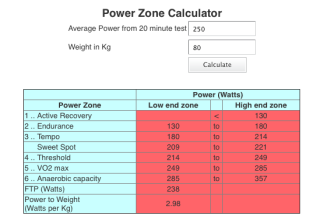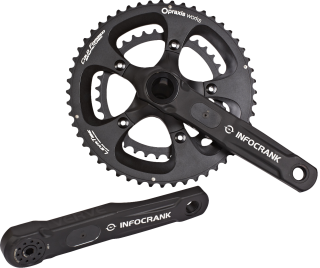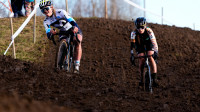Knowledge Level: Intermediate
All the British Cycling Training Plans use heart rate or power zones to specify the intensity at which you should be riding during the workouts. In this series of articles, we will examine all aspects of intensity and why objectively monitoring it is fundamental to cycling success.
In this article we focus on using a power meter to monitor intensity, its advantages, its limitations, how to get the most out of your power meter and how power training zones apply to real workouts and rides.
Advantages of using power
Heart rate can take time to rise to the expected level, a power system informs you from the first pedal strokes if you are within the correct zone. Irrelevant of temperature, fatigue and weather conditions, a power system gives 100% accurate feedback of the output you’re producing.
If your goal is to ride a specific time for a time trial event, power can be used very accurately to gauge the effort required. This degree of pacing accuracy is also extremely valuable for interval sessions, pacing a sportive or eking out your effort during a breakaway.
Training metrics, such as Normalized Power and Training Stress Score, give you objective snapshots and longterm views of how individual sessions and your overall training plan are impacting on your form, fatigue and fitness.
Disadvantages of using power
Cost is still the biggest and most prohibitory factor to riders training with power. Power systems are far more expensive to buy than heart rate monitors but, with more manufacturers and new solutions to measuring power, prices are slowly coming down. Read this article for the latest information on buying a powermeter.
Power meters do not tell you how hard your body is working, only the power you are generating. If on a particular day, you’re power numbers are down, you need to know why. Combining power with heart rate can help to give you a more complete picture.
Finding your training zones
British Cycling recommends conducting a test for Functional Threshold Power (FTP). FTP is the power you could theoretically sustain for a 60 minute effort but is better thought of as your sustainable power which, depending on your level of conditioning could apply to 30-60 minutes. However, unless you regularly ride 40 km time trials, finding the motivation to turn yourself inside out for an hour is extremely difficult. Therefore the British Cycling Testing Protocol uses a 30 minute test with the average power being taken for the final 20 minutes of this period. This figure is then automatically adjusted downwards by 5% by the British Cycling Zone Calculator to give a provenly accurate FTP figure and your personalised power training zones.

What the zones mean
Above is an example of the training zones produced by the British Cycling online zone calculator. The rider averaged 250 Watts during their Functional Threshold Test, resulting in a FTP of 238 Watts and the zones have been calculated based on this figure. The bottom figure in the table is the rider’s power to weight ratio at threshold and is calculated by dividing their FTP score by their weight in kilograms. This figure is probably one of the single best indicators of cycling performance, especially on climbs, and is what you should see rising if you’re following a well designed structured training plan. Both gains in power and reductions in weight will cause this number to rise but it’s always a balancing act and too drastic weight loss can cause significant drops in your power output. The Great Britain Cycling Team nutritionists have given some excellent advice on safe weight loss for cyclists.
Most of the Training Zones are comparable to their heart rate equivalents and, if you’re monitoring both metrics, you should find they correlate closely. For descriptions of the zones, what they feel like and typical sessions involving them, look at the Heart Rate Understanding Intensity Article.
You will however notice, between Zones 3 and 4, a narrow additional zone referred to as Sweet-Spot and that target figures are given for Zone 6, Anaerobic Capacity.
Sweet Spot
What it feels like: The Sweet Spot is found at the upper end of Zone 3 (Tempo) and lower end of Zone 4 (Threshold). As such, you’ll be having to concentrate to maintain it, conversation will be in short sentences and, once you’ve been riding at this intensity for 20-30 minutes plus, you will definitely start to feel fatigue in your legs.
Training with power allows you to accurately sit in this relatively narrow zone. It’s known as the Sweet Spot because it strikes a desirable balance between the training effects you’ll get from the workouts, most significantly a rise in FTP, with a physiological strain that does not require extended recovery.
Typical sessions: Sweet Spot workouts are often used as a bridge between steady state endurance training and more demanding threshold work. As such, many riders will perform 2X20 minute Sweet Spot efforts before building the intensity of this session up to threshold level. Sweet Spot efforts of 5-20 minutes duration are also excellent to add into a commute or a longer endurance ride to get the best return for your session.
Anaerobic Capacity
A power meter gives you an instant reading of the output you’re producing, unlike heart rate which lags behind the effort. For high end work such as Anaerobic Capacity, a power zone can be given.

Making the most of your power meter
A power meter is potentially an incredibly powerful training tool, delivering a bewildering amount of data on every ride you do. To get the most out of your power meter and to fully understand and interpret this data, using analytical software is essential.
TrainingPeaks provides an excellent platform for training with power and British Cycling Members receive up to a 40% discount on monthly subscriptions.
TrainingPeaks have also produced a series of features showing how power data analysis can be applied to a variety of cycling disciplines including a hilly sportive and a circuit race.
There are also a number of books available, including The Power Meter Handbook by Joe Friel, which provides valuable references for power meter users.
It’s also well worth considering employing the services of a British Cycling Level 3 Coach to help you get the most out of your power meter.
Verve Cycling designs and builds innovative bike parts for cyclists, including the InfoCrank, which are renowned for their real-world accuracy and reliability.
The Great Britain Cycling Team uses the data acquired from the InfoCrank to continue to give them the edge as they strive to remain the world’s single most successful cycling team.
British Cycling members receive 15% off the InfoCrank Compact M30 package, click here to find out more: Infocrank discount











